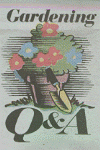

|
All
About Gardening and Gardening Q & A |
|
Bookmark
this page or add it to your favorites now! |
|
"How to Create Your Own Meadow Wildflower Garden" |
|
The concept of planting a wildflower meadow garden in the home landscape is an idea that is catching on. It's possible to create your own wildflower meadow garden - from small to large - at home and some people plant meadows as an alternative to lawn on parts of their property. |
|
All successful wildflower meadow gardens start with careful planning and preparation. In fact, the single most important part is site preparation. The goal is to create a seedbed or planting area that is as weed-free as possible to reduce competition. Dormant weed seeds buried in the ground remain viable for years and when the soil is cultivated these weed seeds may sprout in large numbers. There are several ways wildflower experts recommend to prepare the site, but all involve eliminating any existing turfgrass or undesirable vegetation. The first way does not involve herbicide, but is also the most labor intensive and requires the most amount of time. This method is the one to use if there a wetland or other sensitive area nearby or if you don't want to use an herbicide. With this preparation method the soil is turned regularly throughout the season beginning in spring. Each time the soil is turned, either by rototiller or tractor plow, weed seeds and roots are exposed and killed. Then the site is left alone to let the new weeds grow. Next, the area is cultivated again, turning under the weed seedlings. (This should be done before the weeds bloom and set seed.) The process is repeated as needed throughout the season, possibly a half dozen times or so. Depending on how bad the weed condition is, it may be necessary to do the cultivation process again the second year. The final step before planting is to rake the site to create a smooth seedbed. Once the site for the wildflower meadow garden is prepared, the next step is to select wildflowers appropriate for the site, whether it's a dry meadow or a moist meadow. Also, consider design elements such as color, height, bloom sequence, and patterns. A wildflower meadow garden can be planted by seed, with transplants, or a combination of both. Generally, spring or fall are the best times for planting. Containerized plants can be planted at any time during the growing season if watered during dry periods. |

 Over
the years as I've watched the development of manmade meadows, one of
the things that has struck me most is the ever-changing display of
color I've seen from month to month throughout the season. Because of
its diversity, a meadow will never look the same. I've been following
one manmade wildflower meadow through each season and in late spring
white blooms of Canada anemone appear, quickly followed by baptisia
with its blue flower spikes, golden flowers of coreopsis, and the
familiar oxeye daisy. In summer the meadow becomes home to
butterflies, hummingbirds, and bees attracted to the garden by
butterfly weed, monarda, coneflower, blazing stars, and lilies. The
finale to the season is a display of pastel colors from New England
aster and the bright blooms of goldenrod.
Over
the years as I've watched the development of manmade meadows, one of
the things that has struck me most is the ever-changing display of
color I've seen from month to month throughout the season. Because of
its diversity, a meadow will never look the same. I've been following
one manmade wildflower meadow through each season and in late spring
white blooms of Canada anemone appear, quickly followed by baptisia
with its blue flower spikes, golden flowers of coreopsis, and the
familiar oxeye daisy. In summer the meadow becomes home to
butterflies, hummingbirds, and bees attracted to the garden by
butterfly weed, monarda, coneflower, blazing stars, and lilies. The
finale to the season is a display of pastel colors from New England
aster and the bright blooms of goldenrod. by
Pernell Gerver
by
Pernell Gerver Q.
I first read about your winning the prize in "Organic
Gardening" magazine and am happy to hear you are writing a
column. We have cutworms. We do not use chemicals if we can avoid it.
We dig out the cutworms and have the biggest and fattest cutworms in
our garden. To save my garlic chives, I put collars of aluminum foil
around them and daily dig for cutworms. Somehow I can't find an easy
solution. It is a pleasure to read your articles and please continue
the good work.
Q.
I first read about your winning the prize in "Organic
Gardening" magazine and am happy to hear you are writing a
column. We have cutworms. We do not use chemicals if we can avoid it.
We dig out the cutworms and have the biggest and fattest cutworms in
our garden. To save my garlic chives, I put collars of aluminum foil
around them and daily dig for cutworms. Somehow I can't find an easy
solution. It is a pleasure to read your articles and please continue
the good work. Pernell
Gerver, Horticultural Communication Services All rights reserved.
Pernell
Gerver, Horticultural Communication Services All rights reserved.